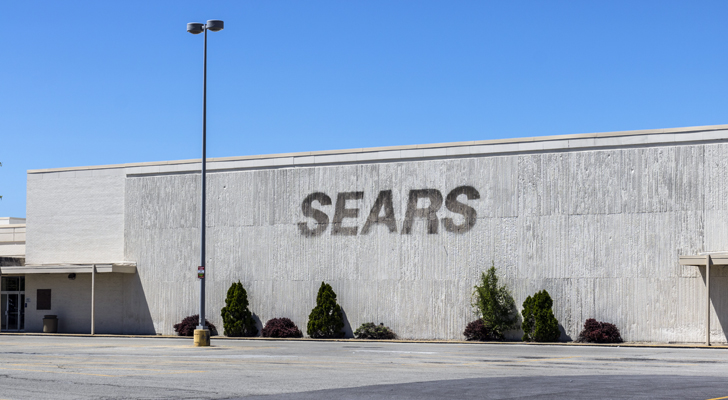A few months ago, a squirrel died on the street in front of our Atlanta house. A giant turkey vulture, weighing roughly 30 pounds, and with a wingspan measured in yards, waited patiently for cars to pass before swooping in and feasting on the carcass. Sears Holdings (OTCMKTS:SHLDQ) is a squirrel. Care to be a turkey vulture in Sears stock?
Sears filed for bankruptcy on Oct. 15, but you can still trade the stock. It even rose 22% on Nov. 8, up a nickel a share to 30 cents. It had a market cap of $33 million on Nov. 9. You can also trade the bonds, at pennies on the dollar, something Carl Icahn said he was considering at the time of the Chapter 11 filing.
But this is not an easy game to play. These bonds are not liquid, and the stock is now listed only on the OTC market, not the main Nasdaq board.
Not Yet Dead
Sears Holdings is in Chapter 11 bankruptcy, not Chapter 7 liquidation. What’s the difference? Billy Crystal’s Miracle Max explained it in The Princess Bride,” “Mostly dead is slightly alive.”
Sears insisted it was not dead in giving this headline to the press release on its Chapter 11 filing. “Sears Holdings Initiates Processes to Accelerate Strategic Transformation and Facilitate Financial Restructuring.”
In the Oct. 15 filing, Sears got $300 million in new financing through its suppliers, who otherwise might get nothing, and said it was negotiating for another $300 million through Cyrus Investments and bank debtors.
One of the suppliers, Hanesbrands (NYSE:HBI), has already written off $14 million and restated its earnings. Meanwhile, the Sears store Web site remains open, but Sears continues to shutter more brick-and-mortar locations. The release on the bankruptcy said some stores even have positive Earnings Before Interest, Taxes, Depreciation and Amortization (EBITDA), and Sears is working to keep them open.
Only 142 out of 687 stores are currently closing, and Sears Holdings’ repair businesses remain open. However, Black Friday will still be happening at Sears. Bring your own crepe.
The Turkey Vulture
To return to our turkey vulture analogy, that has long been Lampert himself, who has been selling and spinning-out the best parts of the company, maintaining large shares, to keep his own ESL Investments hedge fund afloat.
Land’s End (NASDAQ:LE) was spun out in 2014, and it’s down 40% since the spinout. Seritage Growth Properties (NYSE:SRG), which holds the best Sears real estate, is another Lampert creation. So were Sears Canada (OTCMKTS:SRSCQ), which ceased operations this year, and Sears Hometown and Outlet Stores (NASDAQ:SHOS), down 90% from its spinout. Sears has licensed production under its Kenmore home appliance brand and tried to turn DieHard into a chain of repair shops.
Lampert has also used loans to make sure that, if (or more likely when) liquidation occurs, he gets back most of the assets. But despite heavy criticism, he’s taking a bath, too. Lampert originally put his Kmart and Sears together in 2003 for $11 billion — he’s getting a fraction of that out of all these latest machinations, and his image has taken an enormous hit.
The Bottom Line
When a squirrel dies, turkey vultures feast.
Those investors who are willing to compete with the biggest vulture at this feast, Mr. Lampert, are mainly taking risks with money they have already lost, in the form of debt, equity or merchandise.
Lampert is selling the idea that Sears is mostly dead but slightly alive. Those who are putting money into it, meanwhile, are completing Miracle Max’ quote. “With all dead there’s usually only one thing you can do. Go through his clothes and look for loose change.”
Bankruptcies are entertaining if you’re not invested in them.
Dana Blankenhorn is a financial and technology journalist. He is the author of a new mystery thriller, The Reluctant Detective Finds Her Family, available now at the Amazon Kindle store. Write him at danablankenhorn@gmail.com or follow him on Twitter at @danablankenhorn. As of this writing, he owned no shares in companies mentioned in this story.

